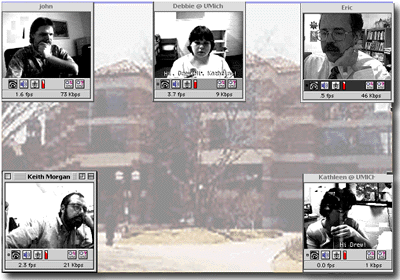
It's the dead of winter at the University of Michigan at Ann Arbor -- a blinding blizzard and subzero temperatures. A student has a question for a reference librarian, and she'd like to go over to the Shapiro Undergraduate Library and ask. But trudging across campus is the last thing she wants to do.
Fortunately for her, the Internet is bringing the reference librarian closer to home. At several residence-hall libraries at the university, the staff has set up a videoconferencing system that lets students see and hear a reference librarian who is on duty at the main library. The students can make video-enhanced telephone calls to the main reference desk that are the next best thing to being there.
"It's like The Jetsons," says Kathleen M. Folger, a reference librarian at the university, recalling the use of videophones in the futuristic cartoon series on television in the 1960s.
The library started the high-tech project, called the Interactive Reference Assistance program, in October 1995, and it was an immediate hit. "The students just really enjoy using it," Ms. Folger says. "They're fascinated by the technology."
The University of Michigan's library is one of the first to experiment with on-line videoconferencing in this way, but Ms. Folger and her colleagues are not the only ones interested in seeing their patrons on the computer screen.
In fact, a librarian at North Carolina State University has set up a forum to discuss videoconferencing in libraries. Appropriately, the forum takes place on an Internet-based videoconference.
One of the objectives of the forum is simply to find out how many librarians have the cameras and the know-how to tune in, says its creator, Eric L. Morgan. The results so far have been promising. One day in early July, six librarians from institutions in four U.S. states were on line, their smiling faces visible in small boxes on their computer screens. For more than an hour, they discussed everything from how to use the free "CU-See Me" software that makes this type of videoconferencing possible to whether offering the on-line reference service was worth the trouble.
Ms. Folger, one of the participants, did much of the talking, as other librarians quizzed her about the University of Michigan's teleconferencing experiment.
"The biggest problem we had was technical support," she told the group. "There's no number to call to ask for help because it's all freeware." This fall the university plans to try a commercial software package and to upgrade from black-and-white to color cameras.
One of the biggest surprises, Ms. Folger says, was how much more comfortable most students felt on camera than in person. "Students will talk to you and be much more open with you than if they were here in person," she says. "The first night we did it, I had students flirting with me. I had one student ask me out."
Both Ms. Folger and Mr. Morgan say that the unique experience of talking with a librarian in virtual space -- with its unusual mix of personal interaction and private setting -- makes the service worthwhile.
Ms. Folger admits, however, that there are some students who would just as soon pick up the phone and not be seen by their librarians. "Some of the females when they saw themselves on the camera said, 'Oh my hair looks awful.'"
Mr. Morgan plans to keep the forum open all summer. Librarians can check in at any time to see if their colleagues are talking shop.
--Jeffrey R. Young
Reprinted with permission to the see-a-librarian home page. Copyright (c) 1996 by The Chronicle of Higher Education Inc.
Reprinted with permission to the see-a-librarian mailing list. Copyright (c) 1996 by The Chronicle of Higher Education Inc.